engine coolant NISSAN GT-R 1998 Service Manual
[x] Cancel search | Manufacturer: NISSAN, Model Year: 1998, Model line: GT-R, Model: NISSAN GT-R 1998Pages: 230, PDF Size: 12.66 MB
Page 9 of 230
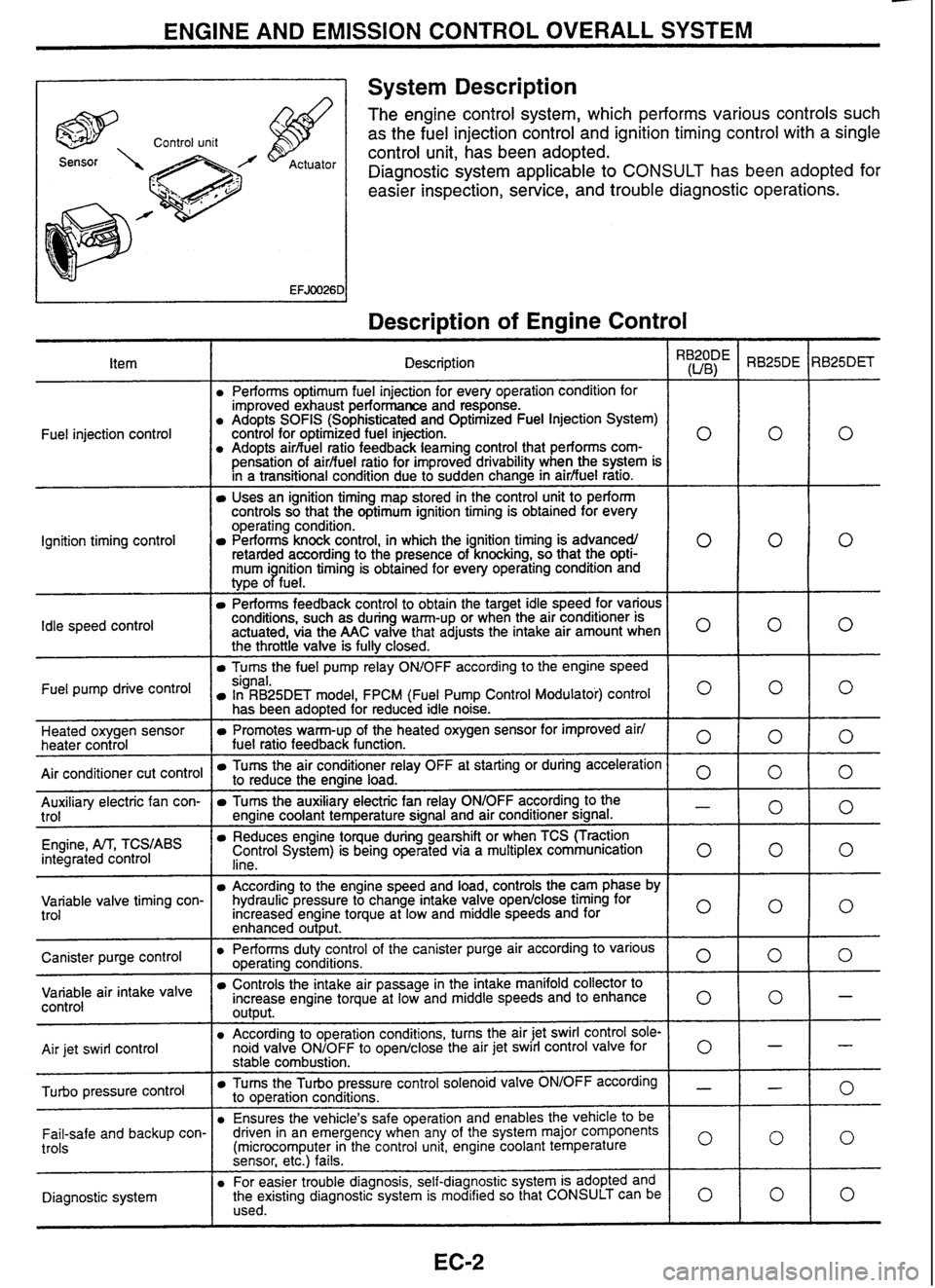
ENGINE AND EMISSION CONTROL OVERALL SYSTEM
A 1 System Description
The engine control system, which performs various controls such
as the fuel injection control and ignition timing control with a single
control unit, has been adopted.
Diagnostic system applicable to
CONSULT has been adopted for
easier inspection, service, and trouble diagnostic operations.
Description of Engine Control
I
Description \,
Performs optimum fuel injection for every operation condition for
improved exhaust performance and response.
Adopts
SOFlS (Sophisticated and Optimized Fuel Injection System)
control for optimized fuel injection.
Adopts
airbuel ratio feedback
learning control that performs
com-
0
pensation of airfiuel ratio for improved drivability when the system is
in a transitional condiiion due to sudden change in
airfiuel ratro.
Uses an ignition timing map stored in the control unit to perform
controls so that the optimum ignition timing is obtained for every
operating condition.
Performs knock control, in which the ignition timing is advancedl
retarded according to the presence of knocking, so that the
opti- 0
mum i nition timing is obtained for every operating condition and
type
oPfue1.
Performs feedback control to obtain the target idle speed for various
conditions, such as during warm-up or when the air conditioner is
actuated, via the
AAC valve that adjusts the intake air amount when
O
the throttle valve is fully closed.
Turns the fuel pump relay OWOFF according to the engine speed
Fuel
injection control
Ignition timing control
Idle
speed
control
Fuel pump drive signal. In RB25DET model, FPCM (Fuel Pump Control Modulatoi) control O
has been adopted for reduced idle noise.
Heated oxygen sensor
heater control
Air conditioner cut control
Promotes warm-up of the heated oxygen sensor for improved air1
fuel ratio feedback function. 0
Tums the air conditioner relay OFF at starting or during acceleration to reduce the engine load. 0 -- Auxiliary electric fan con-
trol
Engine,
M, TCS,ABS integrated control
Tums the auxiliary electric fan relay ONIOFF according to the - engine coolant temperature signal and air conditioner signal.
Reduces engine toque during gearshift or when TCS (Traction
Control System) is being operated via a multiplex communication
lino 0
- -
Variable valve timing con-
trol According to the engine speed and load, controls the cam phase by
hydraulic pressure to change intake valve
open/close timing for
Increased engine torque at low and middle speeds and for
enhanced
out~ut.
I o I
Canister purge control air
intake valve control
Air
jet swirl control Performs duty
control of the canister purge air according to various ooeratina conditions.
0 -r-~ e-- ---
-
Controls the intake air passage in the intake manifold collector to
increase engine torque at low and middle speeds and to enhance
output. 0
According to operation conditions, turns the air jet swirl control sole-
noid valve ONIOFF to openlclose the air jet swirl control valve
for 0
pressure control
stable combustion.
Tums the Turbo pressure control solenoid valve ONIOFF according - to operation conditions.
Ensures the vehicle's safe operation and enables the vehicle
to be
Fail-safe and backup con-
trols
Diagnostic system driven
in an emergency when any of the system major components
(microcomputer in the control unit, engine coolant temperature
0
sensor, etc.) fails.
For easier trouble diagnosis, self-diagnostic system is adopted and
the existing diagnostic system is modified so that CONSULT can be
0 used.
Page 11 of 230
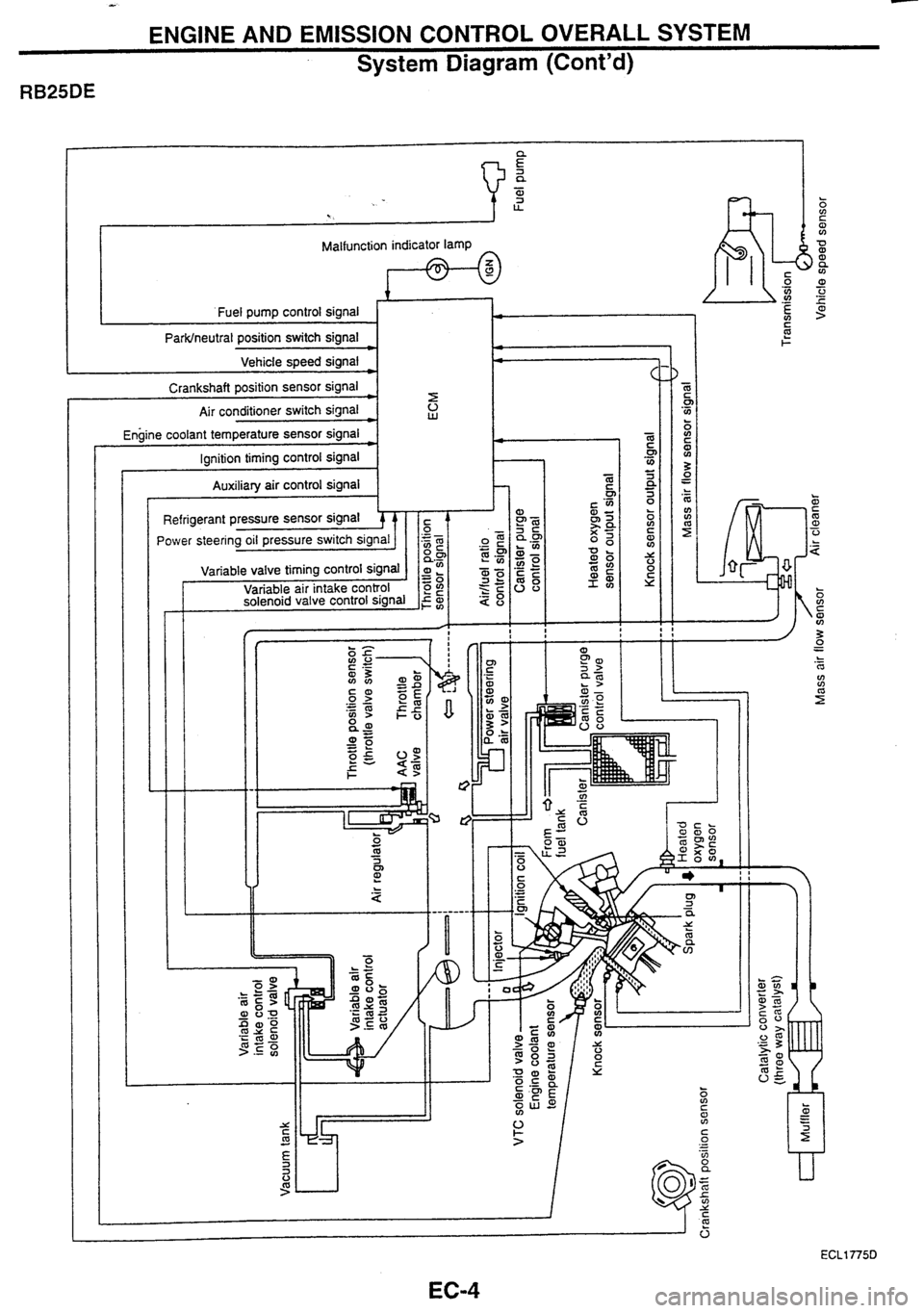
ENGINE AND EMISSION CONTROL OVERALL SYSTEM
System
Diagram (Cont'd)
a
E a - al 1 U.
Malfunction indicator lamp
Fuel pump control signal
+
ParWneutral position switch signal 2 - 1 F
Vehicle speed signal D 4 -
Crankshaft position sensor signal - - - m 2 c 0, Air conditioner switch signal * Y .- "Y
~ngine coolant temperature sensor signal - B * 4 C C Ignition timing control signal 0, P - ID - - Auxiliary air control signal a C - 2s
Refrigerant pressure sensor signal +
Power steering oil pressure switch signal
Variable valve timing control sign
- Variable air intake control
I I
solenoid valve control sig
Page 12 of 230
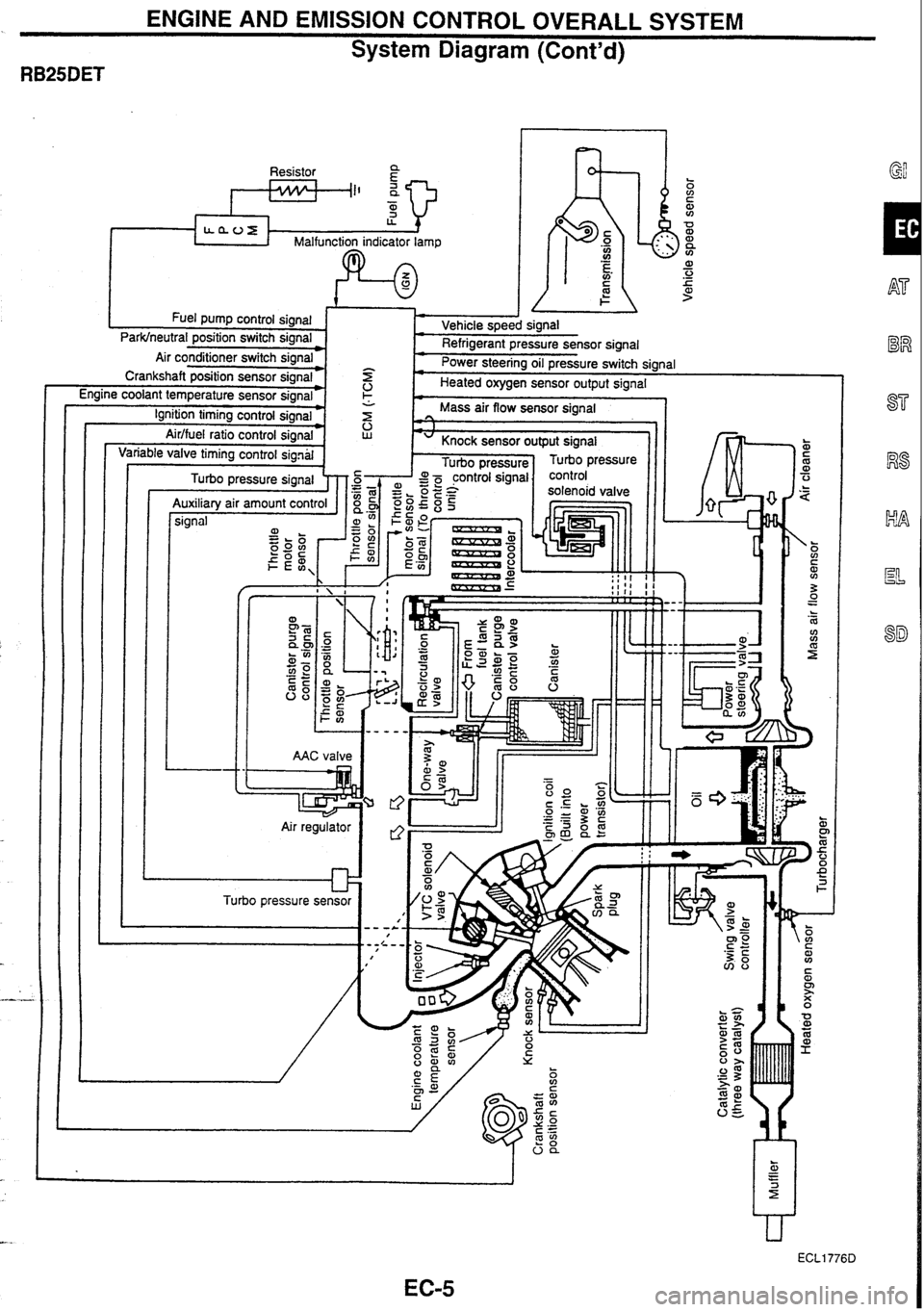
ENGINE AND EMISSION CONTROL OVERALL SYSTEM
System Diagram (Cont'd)
Resistor a
I I~I I 1
w
C LLOE Malfunction indicator lamo
I Fuel DU~D control sional I Vehicle soeed sianal I
Parklneutral position switch signan I Refrigerant pressure sensor sianal
Air conditioner switch signal- rr -
- Power steering oil pressure switch signal
Crankshaft position sensor signal s - 0 Heated oxygen sensor output signal
Engine coolant temperature sensor signalC k - Mass air flow sensor signal r
- Ignition timing control signal ,- U I W Knock sensor output signal
Airlfuel
ratio control
signal-
Variable valve
timing
control
s~anal
Turbo pressure signal
Auxiliarv
air amount control
I
signal 2 L
g E8z E $, r
Air regulator
LT Turbo pressure sensor
Page 13 of 230
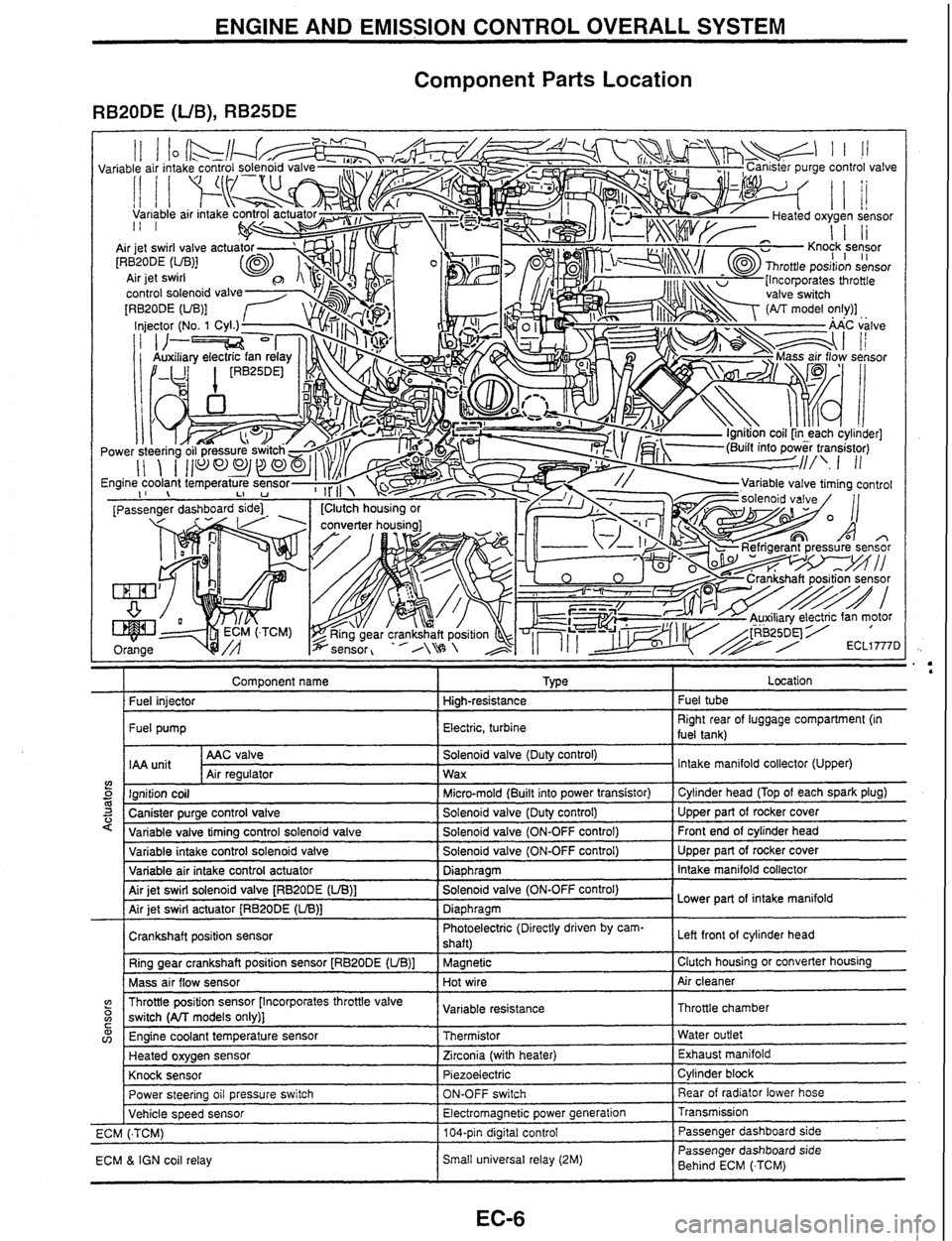
ENGINE AND EMISSION CONTROL OVERALL SYSTEM
Component Parts Location
RB20DE (UB), RB25DE
Component name I Type I Location
I Fuel iniector I Hiah-resistance I Fuel tube
I Fuel pump I Electric, turbine I Right rear of luggage compartment (in
fuel tank)
AAC valve
IAA
unit Air reaulator
5 m 3 '
Solenoid valve (Duty control)
Wax
variable intake control solenoid valve
Variable air intake control actuator
Air jet swirl solenoid valve
[RBPODE (UB)]
Air jet swirl actuator
[RB20DE (LIB)]
Crankshaft position sensor Ring gear crankshaft position sensor
[RB20DE (UB)]
Mass air flow sensor Intake
manifold collector (Upper)
Ignition coil
Canister purge control valve
Variable valve tirnina control
solenoid valve
(? o C
Solenoid valve (ON-OFF control)
Diaphragm
Solenoid valve (ON-OFF control)
Diaphragm Photoelectric (Directly driven by cam-
shaft)
Magnetic
Hot wire
w v,
Micro-mold (Built into power transistor)
Solenoid valve (Duty control)
Solenoid valve (ON-OFF control) Upper part of rocker cover
Intake manifold collector
Lower part of intake manifold
Left front
of cylinder head
Clutch housing or converter housing
Air cleaner
Throttle position sensor [Incorporates throttle valve
switch
(All models only)]
Power steering oil pressure switch
Vehicle speed sensor
ECM
(.TCM)
ECM
& IGN coil relay Cylinder head
(Top of each spark plug)
Upper part of rocker cover
Front end of cylinder head
Engine coolant temperature sensor
Heated oxygen sensor
Knock sensor Variable
resistance
ON-OFF switch
Electromagnetic power generation
104-pin digital control
Small universal relay (2M) Throttle chamber
Thermistor
Zirconia (with heater)
Piezoelectric Rear of radiator lower hose
Transmission Passenger dashboard side
Passenger dashboard side
Behind ECM
(.TCM) Water
outlet
Exhaust manifold
Cylinder block
Page 14 of 230
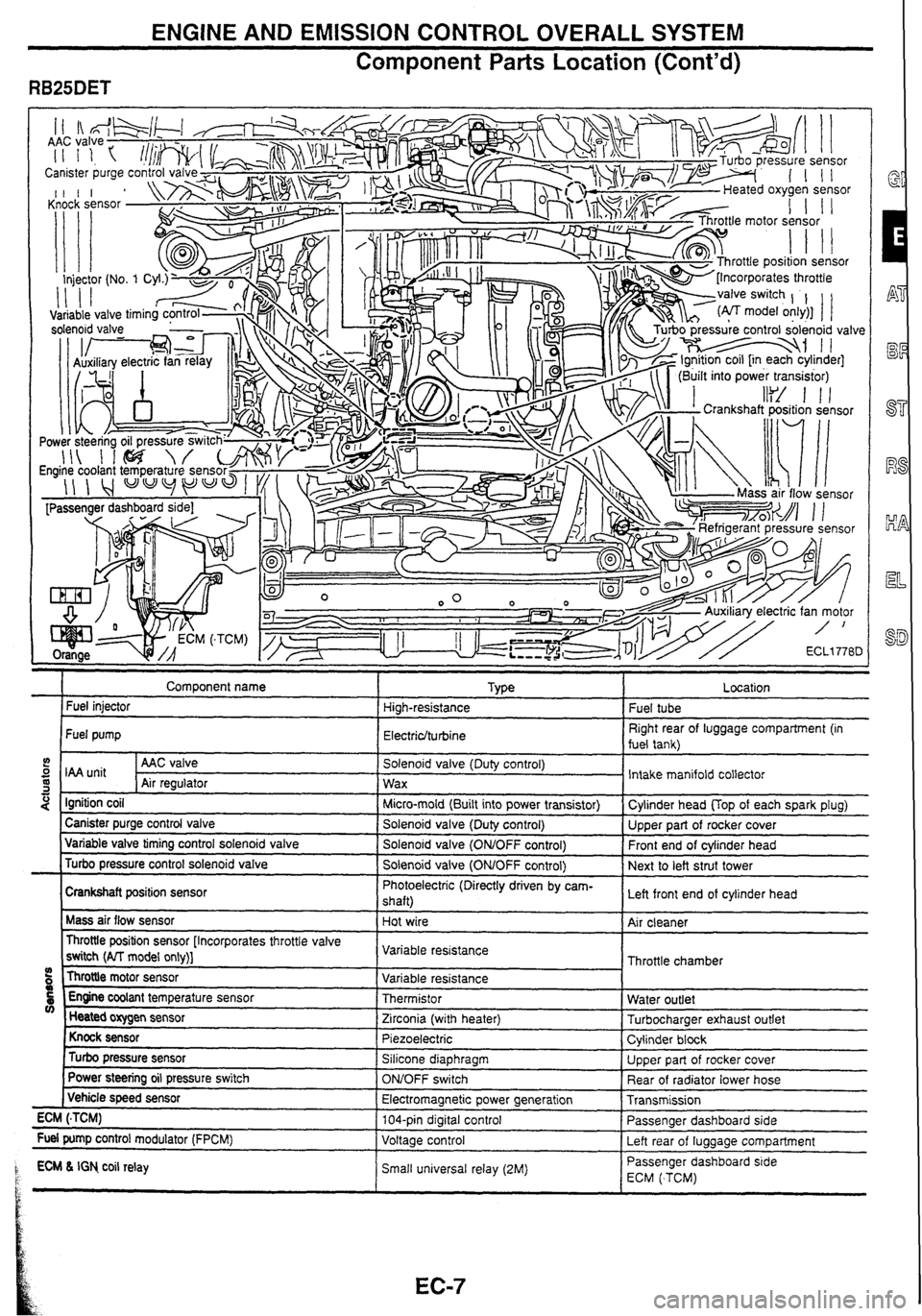
ENGINE AND EMISSION CONTROL OVERALL SYSTEM
Component
Parts Location (Cont'd)
" . . ., . .7
Comoonent name I TVLE a r Fuel injector High-resistance
Fuel pump
Electriclturbine
5 I unit I AAC valve I Solenoid valve (Duty control)
S Air reoulator 1 wax -1 I " - . -.
4 Ignition coil I Micro-mold (Built into power transistor)
I Canister purge control valve I Solenoid valve (Dutv control) ---- - Variable valve timing control solenold valve I Solenold valve (ONtOFF control)
Turbo pressure control solenoid valve
I Solenoid valve (OMOFF control)
Crankshaft position sensor Photoelectric
(Directly driven by cam-
shaft)
Mass air flow sensor
Hot wire
Throttle position sensor [Incorporates throttle valve
switch
(AlT model only)] Variable
resistance
Throttle motor sensor
09 Variable resistance
5 Engine coolant temperature sensor Thermistor V) Heated oxygen sensor
Zirconia (with heater)
Knock sensor Piezoelectric
Turbo pressure sensor Silicone diaphragm
Power
steering oil pressure switch
ONJOFF switch
( Vehicle speed sensor
Electromagnetic power generation
ECM
(.TCM) 104-pin digital control
Fuel pump control modulator (FPCM)
Voltage control
1 ECM L IGN co~l relay Small un~versal relay (2M) P t
.
Fuel tube
Right rear of luggage compartment (in
fuel tank)
Intake manifold collector
Cvlinder head
UOD of each soark olua)
Upper part of rocker cover
Front end of cylinder head
Next to left strut tower
Left front end of cylinder head
Air cleaner
Throttle chamber
Water outlet
Turbocharaer exhaust outlet
Cylinder
block
Upper part of rocker cover
Rear of radiator lower hose
Transmission
Passenger dashboard side
Left rear of
luaaaae comoartment
-- Passenger dashboard s~de
ECM ( TCM)
Page 20 of 230
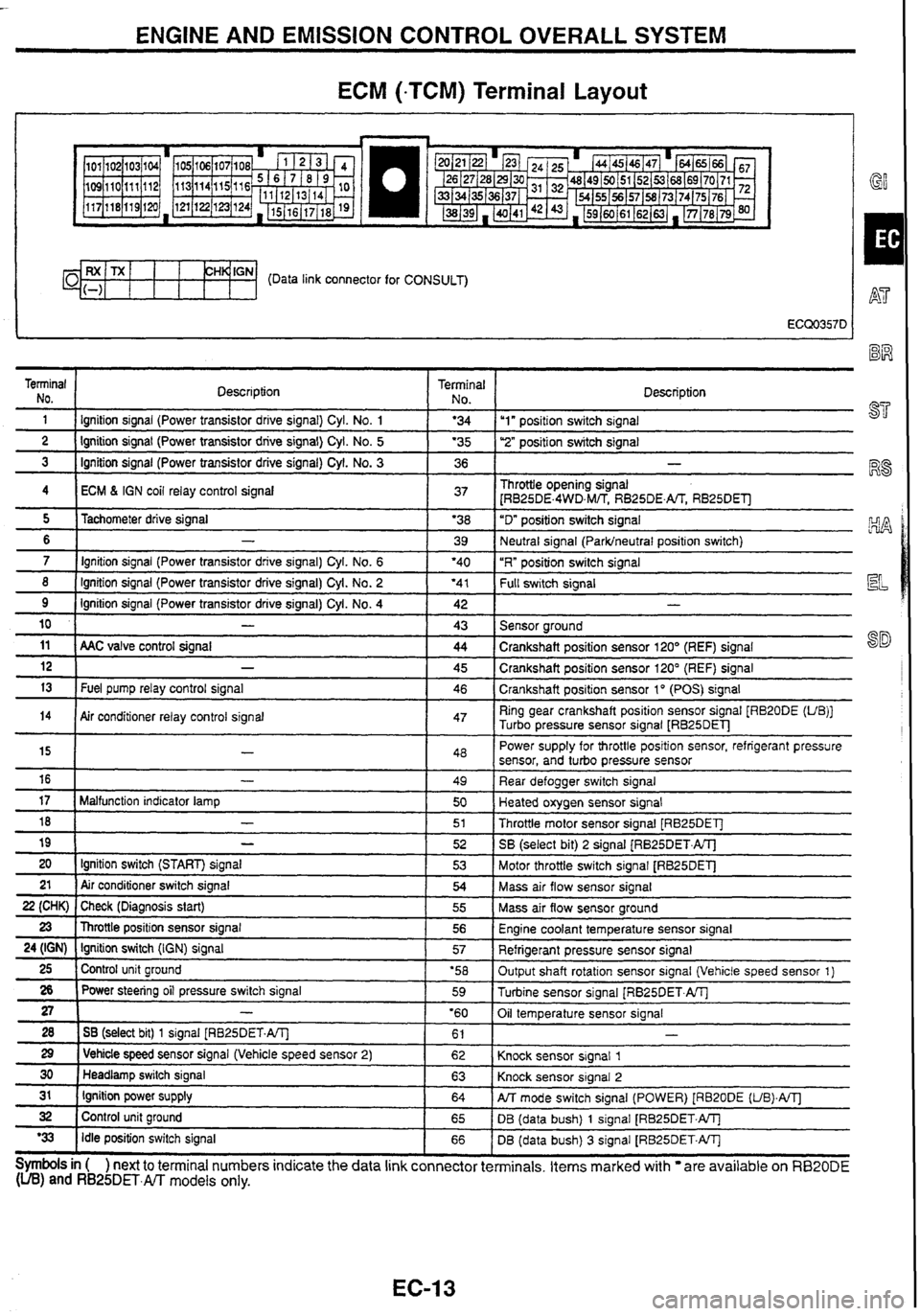
ENGINE AND EMISSION CONTROL OVERALL SYSTEM
ECM (-TCM) Terminal Layout
I GY
CH~'GN- (Data link connector for CONSULT)
Terminal NO.
1 Description Terminal 1 No I Description - - 1 I lgnition
signal (Power transistor drrve signal) Cyl. No. 1 1 '34 Iu1" positron switch signal -- ---- 2 1 Ignition signal (Power transistor drive signal) Cyl. No. 5 1 '35 1 ''2" posifion switch signal - - 3 1 Ignition signal (Power transistor drive signal) Cyl. No. 3 1 36 1 -
4 I ECM 6 IGN coil relay control signal 1 37 1 Throttle opening signal
[RB25DE.4WD,M/TS RB25DE.m RB25DEll
- - - -- - - - - 8 ( Ignition signal (Power transistor drive signal) Cyl. No. 2 ( '41 1 f-k swltch signal
5
6
7
11 ( AAC valve control signal ( 44 1 Crankshaft position sensor 120' (REF) signal
Tachometer
drive signal
-
Ignition signal (Power transistor drive signal) Cyl. No. 6
9
10
'38
39
'40
Ignition signal (Power transistor drive signal)
Cyl.
No. 4
-
12
13
"D" position switch signal
Neutral signal
(Parklneutral position switch)
"R" position switch signal
14
Symbols in ( ) next to terminal numbers indicate the data link connector terminals. Items marked with are available on RB20DE (UB) and RB25DET.m models only.
42
43
-
Fuel pump relay control signal
15
16
17
18
19
20 21
22 (CHK)
23
24 (IGN)
25
26
27
28
29
30
31
32
'33
- -
Sensor around
Air conditioner relay control signal 45
46
-
-
Malfunction indicator lamp
-
-
Ignition switch (START) signal
Air conditioner switch signal
Check (Diagnosis start)
Throttle position sensor signal
Ignition switch
(IGN) signal
Control unit ground
Power steering oil pressure switch signal
-
1 SB (select bit) 1 signal [RB25DET.A/Tl
1 Vehicle speed sensor signal (Vehicle speed sensor 2)
Headlamp switch signal
Ignition power supply
Control unit ground
Idle position switch signal Crankshaft
position sensor 120" (REF) signal
Crankshaft position sensor 1
" (POS) signal
47 Ring gear crankshaft position sensor signal [RB20DE (UB)]
Turbo pressure sensor signal
LRB25DEl-J
48
49
50
51
52
53
54
55
56
57
'58 59
'60 61
62
63
64
65
66 Power
supply for throttle position sensor, refrigerant pressure
sensor, and turbo pressure sensor
Rear defogger switch signal
Heated oxygen sensor signal
Throttle motor sensor signal [RB25DET]
SB
(select bit)
2 signal (RB25DET.ATJ
Motor throttle switch signal
[RB25DET]
Mass air flow sensor signal
Mass air flow sensor ground
Engine coolant temperature sensor signal
Refrigerant pressure sensor signal
Output shaft rotation sensor signal (Vehicle speed sensor 1)
Turbine sensor signal
[RB25DET.AlTj
Oil temperature sensor signal
Knock sensor signal
1
Knock sensor signal 2
PJT mode switch signal (POWER) [RB20DE (UB).A/Tl
DB (data bush) 1 signal [RB25DET.W
DB (data bush)
3 signal [RB25DET.W
Page 22 of 230
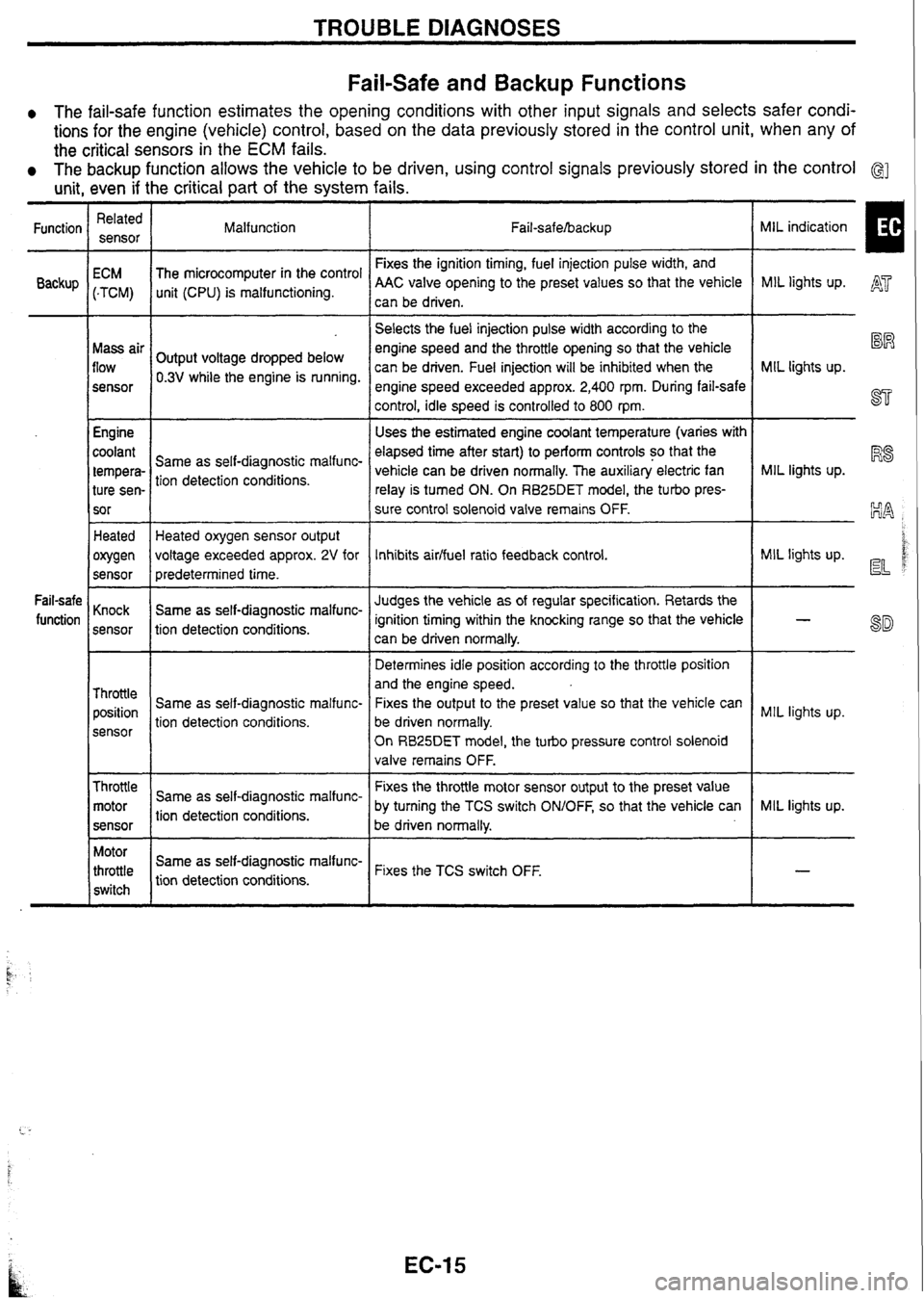
TROUBLE DIAGNOSES --- - - - -- -- - -
Fail-safe and Backup Functions
0 The fail-safe function estimates the opening conditions with other input signals and selects safer condi-
tions for the engine (vehicle) control, based on the data previously stored in the control unit, when any of
the critical sensors in the
ECM fails.
The backup function allows the vehicle to be driven, using control signals previously stored in the control G]
unit, even if the critical part of the system fails.
MIL indication
I
Related
sensor
Function
Backup Malfunction
Fail-safehacku p
Fixes the ignition timing, fuel injection pulse width, and
AAC valve opening to the preset values so that the vehicle
can be driven.
ECM
(-TCM)
Mass air
flow
sensor
Engine
coolant
tempera- ture sen-
sor The
microcomputer in the control
unit (CPU) is malfunctioning. MIL lights
up. A'
-- --
Selects the fuel injection pulse width according to the
engine speed and the throttle opening so that the vehicle
can be driven. Fuel injection will be inhibited when the
engine speed exceeded approx.
2,400 rpm. During fail-safe
control, idle speed is controlled to 800
rpm.
Uses the estimated engine coolant temperature (varies with
elapsed time after start) to perform controls so that the
vehicle can be driven normally. The auxiliary electric fan
relay is turned ON. On
RB25DET
model, the turbo pres-
sure control solenoid valve remains OFF.
%R
MIL lights up.
ST
Output voltage dropped below
0.3V while the engine is running.
MIL lights up.
R8 Same as self-diagnostic malfunc-
tion detection conditions.
Heated
owen
sensor Heated oxygen sensor output
voltage exceeded approx.
2V for
predetermined time.
Same as self-diagnostic malfunc-
tion detection conditions. MIL
lights up. d d Inhibits aidfuel ratio feedback control.
Judges the vehicle as of regular specification. Retards the
ignition timing within the knocking range so that the vehicle
can be driven normally.
Determines idle position according to the throttle position
and the engine speed.
Fixes the output to the preset value so that the vehicle can
be driven normally.
On
RB25DET model, the turbo pressure control solenoid
valve remains OFF.
Fail-safe
function Knock
sensor
Throttle position
sensor Same
as self-diagnostic malfunc-
tion detection conditions. MIL
lights up.
Throttle motor
sensor
--
Fixes the throttle motor sensor output to the preset value
by turning the TCS switch
ONIOFF, so that the vehicle can
Same
as self-diagnostic malfunc-
tion detection conditions. MIL
lights up.
be driven normally.
Motor
throttle
switch Same
as
self-diag
nostic
malfunc-
tion detection conditions. Fixes the
TCS switch OFF.
t.. -
Page 24 of 230
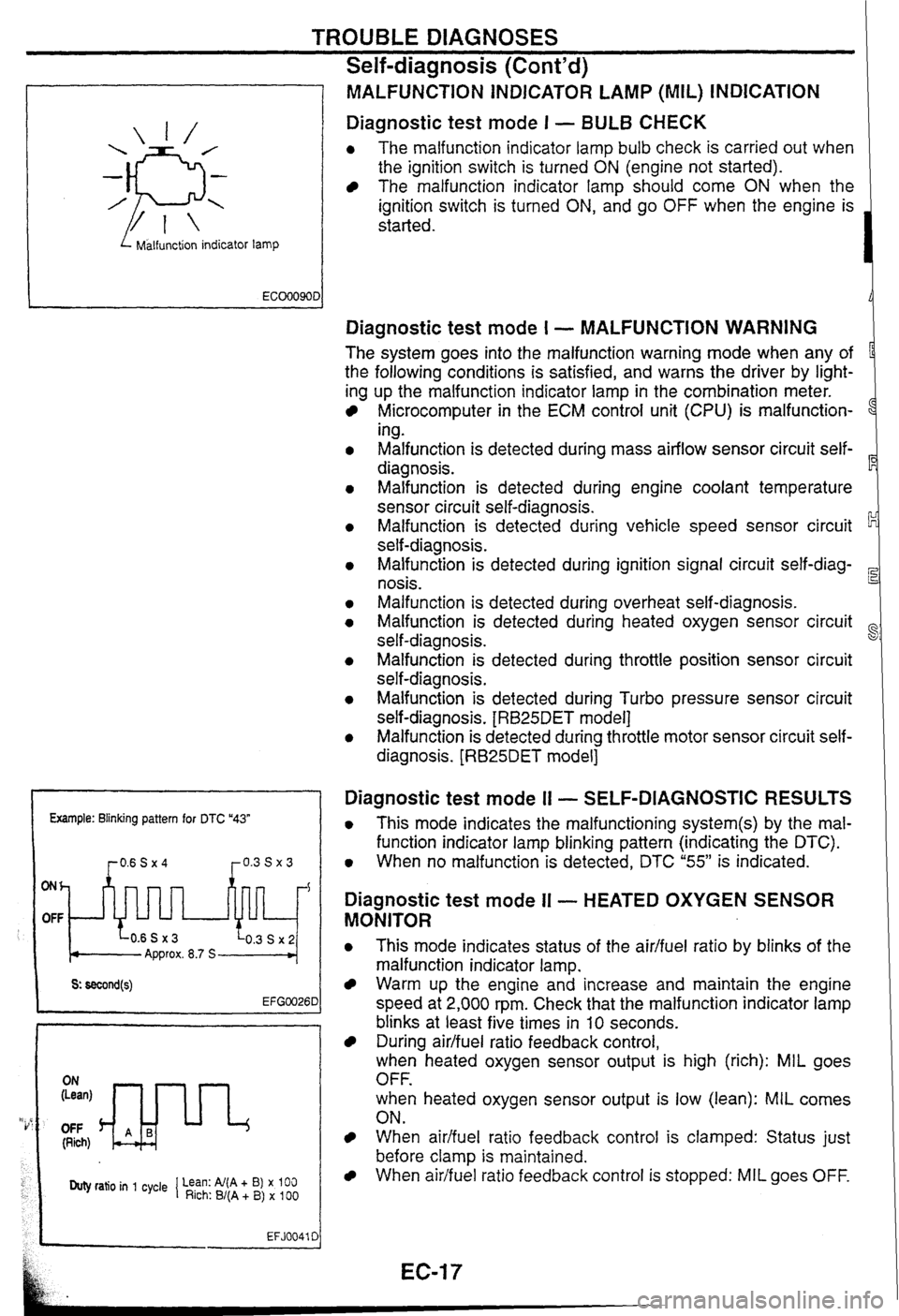
TROUBLE DIAGNOSES
Self-diagnosis (Cont'd)
I Malfunction indicator lamp
MALFUNCTiON INDICATOR LAMP (MIL) INDICATION
Diagnostic test mode I - BULB CHECK
0 The malfunction indicator lamp bulb check is carried out when
the ignition switch is turned
ON (engine not started).
The malfunction indicator lamp should come ON when the
ignition switch is turned
ON, and go OFF when the engine is
started.
Example: Blinking pattern for DTC "43"
ONh
OFF
Approx. 8.7 S
OFF (Rich)
Duty ratio in 1 cycle 1 Lean: Al(A + B) x 100 Rich: B/(A + B) x 100
EFJ0041 C
Diagnostic test mode I - MALFUNCTION WARNING
The system goes into the malfunction warning mode when any of
the following conditions is satisfied, and warns the driver by light-
ing up the malfunction indicator lamp in the combination meter.
Microcomputer in the ECM control unit (CPU) is malfunction-
1
ing.
Malfunction is detected during mass airflow sensor circuit self-
diagnosis.
Malfunction is detected during engine coolant temperature
sensor circuit self-diagnosis.
Malfunction is detected during vehicle speed sensor circuit
self-diagnosis.
Malfunction is detected during ignition signal circuit
self-diag-
nosis.
Malfunction is detected during overheat self-diagnosis.
Malfunction is detected during heated oxygen sensor circuit
self-diagnosis.
~alfunsion is detected during throttle position sensor circuit
self-diagnosis.
Malfunction is detected during Turbo pressure sensor circuit
self-diagnosis.
[RB25DET model]
Malfunction is detected during throttle motor sensor circuit self-
diagnosis.
[RB25DET model]
Diagnostic test mode I1 - SELF-DIAGNOSTIC RESULTS
0 This mode indicates the malfunctioning system(s) by the mal-
function indicator lamp blinking pattern (indicating the DTC).
0 When no malfunction is detected, DTC "55" is indicated.
Diagnostic test mode II - HEATED OXYGEN SENSOR
MONITOR
0 This mode indicates status of the aidfuel ratio by blinks of the
malfunction indicator lamp.
Warm up the engine and increase and maintain the engine
speed at 2,000 rpm. Check that the malfunction indicator lamp
blinks at least five times in
10 seconds.
During airlfuel ratio feedback control,
when heated oxygen sensor output is high (rich): MIL goes
OFF.
when heated oxygen sensor output is low (lean):
MIL comes
ON.
When aidfuel ratio feedback control is clamped: Status just
before clamp
is maintained.
When airifuel ratio feedback control is stopped: MIL goes OFF.
Page 25 of 230
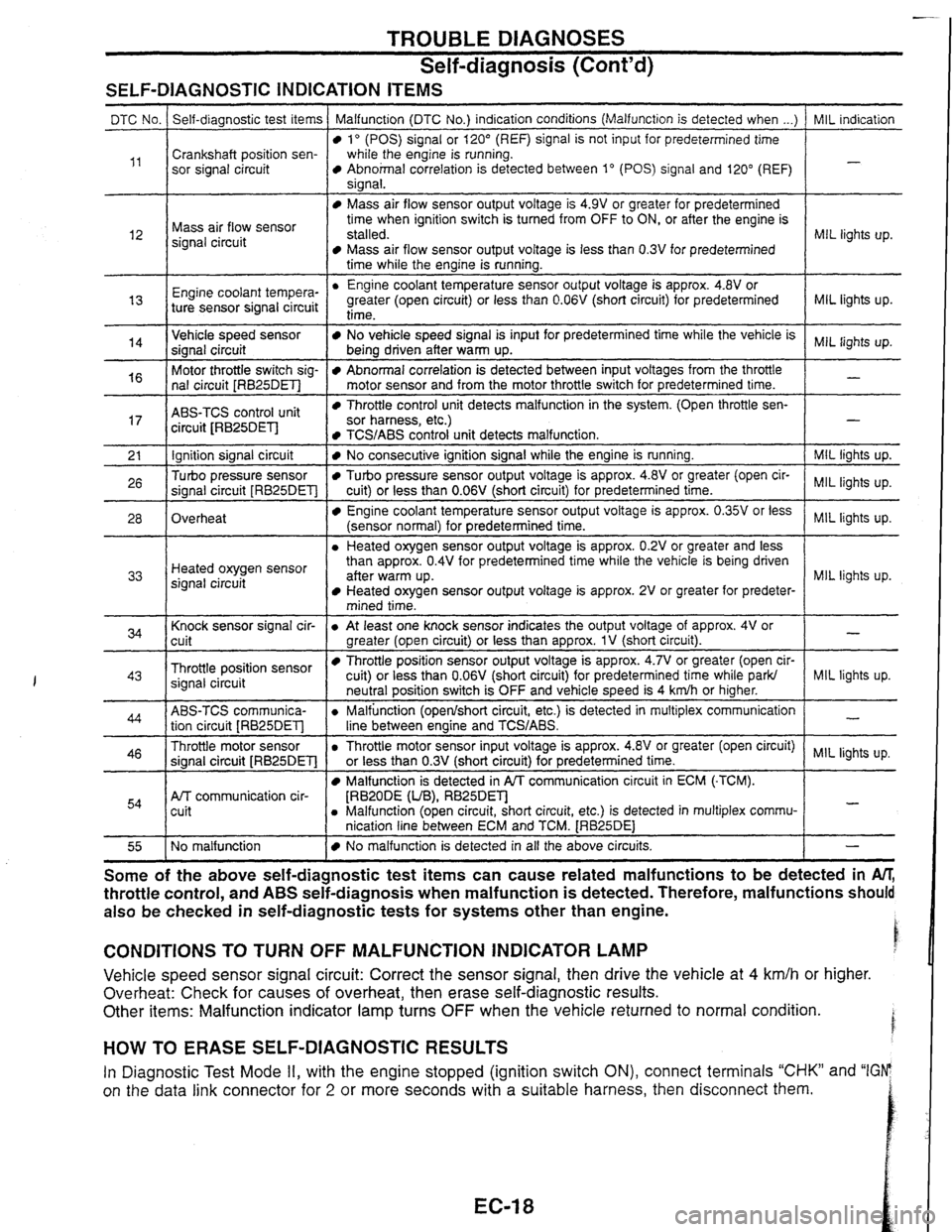
TROUBLE DIAGNOSES
Self-diagnosis
(Cont'd)
SELF-DIAGNOSTIC INDICATION ITEMS
I time while the engine is running. I
MIL indication
-
DTC No.
,,
MIL lights up. l2
Self-diagnostic test items
Crankshaft position sen-
sor signal circuit Malfunction (DTC No.)
indication conditions (Malfunction is detected when ...)
lo (POS) signal or 120" (REF) signal is not input for predetermined time
while the engine is running.
Abnohal correlation is detected between 1" (POS) signal and 120" (REF)
sianal.
Mass air flow sensor
signal circuit
MIL lights up.
Engine coo'ant tempera-
"
Mass air flow sensor output voltage is 4.9V or greater for predetermined
time when ignition switch is turned from OFF to ON, or after the engine is
stalled.
Mass air flow sensor output voltage is less than 0.3V for predetermined
Engine coolant temperature sensor output voltage is approx.
4.8V or
greater (open circuit) or less than
0.06V (short circuit) for predetermined
MIL lights up.
-
14
ABS-TCS control unit
circuit JRB25DEl-l
ture sensor signal circuit Throttle control unit detects malfunction
in the system. (Open throttle sen- sor harness, etc.)
Ignition signal circuit
Turbo pressure sensor
signal circuit
[RB25DET]
Overheat
I 1 mined time. I
time-
Vehicle speed sensor
signal circuit
Motor throttle switch sig-
nal circuit
[RB25DET]
TCS/ABS control unit detects malfunction. 1 -
I Knock sensor signal cir-
cuit
- --
No vehicle speed signal is input for predetermined time while the vehicle is
being driven after warm up.
Abnormal correlation is detected between input voltages from the throttle
motor sensor and from the motor throttle switch for predetermined time.
I
MIL lights up. Heated oxygen sensor
signal circuit
Throttle position sensor
signal circuit
No consecutive ignition signal while the engine is running.
Turbo pressure sensor output voltage is approx. 4.8V or greater (open cir-
cuit) or less than
0.06V (short circuit) for predetermined time.
Engine coolant temperature sensor output voltage is approx. 0.35V or less
(sensor normal) for predetermined time.
a Heated oxygen sensor output voltage is approx. 0.2V or greater and less
than approx.
0.4V for predetermined time while the vehicle is being driven
aner warm up. Heated oxygen sensor output voltage is approx. 2V or greater for predeter-
ABS-TCS communica- tion circuit
[RB25DET]
Throttle motor sensor
signal circuit
[RB25DET]
Afr communication cir-
cuit
MIL lights up.
lights
up.
MIL lights up.
NQ malfunction
I a At least one knock sensor indicates the output voltage of approx. 4V or
greater (open circuit) or less than approx.
1V (short circuit).
Throttle position sensor output voltage is approx. 4.7V or greater (open cir-
cuit) or less than
0.06V
(short circuit) for predetermined time while ark/
a Throttle motor sensor input voltage is approx. 418~or greater (open circuit) MIL lights up.
or less than
0.3V
(short circuit) for predetermined time. I
-
MIL liqhts up. neutral position switch is OFF and vehicle speed is 4 kdh or higher.
a Malfunction (openlshort circuit, etc.) is detected in multiplex communication
line between enaine and
TCWABS.
Malfunction is detected in PA communication circuit in ECM (-TCM).
[RBZODE (UB), RB25Dm a Malfunction (open circuit, short circuit, etc.) is detected in multiplex commu-
nication line between ECM and TCM.
[RB25DE1
-
-
No malfunction is detected in all the above circuits. I - - --
Some of the above ~elfaia~nostic test items can cause related malfunctions to be detected in M,
throttle control, and ABS seif-diagnosis when malfunction is detected. Therefore, malfunctions should
also be checked in self-diagnostic tests for systems other than engine.
CONDITIONS TO TURN OFF MALFUNCTION INDICATOR LAMP
Vehicle speed sensor signal circuit: Correct the sensor signal, then drive the vehicle at 4 km/h or higher.
Overheat: Check
for causes of overheat, then erase self-diagnostic results.
Other items: Malfunction indicator lamp turns
OFF when the vehicle returned to normal condition.
HOW TO ERASE SELF-DIAGNOSTIC RESULTS
In Diagnostic Test Mode II, with the engine stopped (ignition switch ON), connect terminals "CHK" and "IGFP
on the data link connector for
2 or more seconds with a suitable harness, then disconnect them.
Page 28 of 230
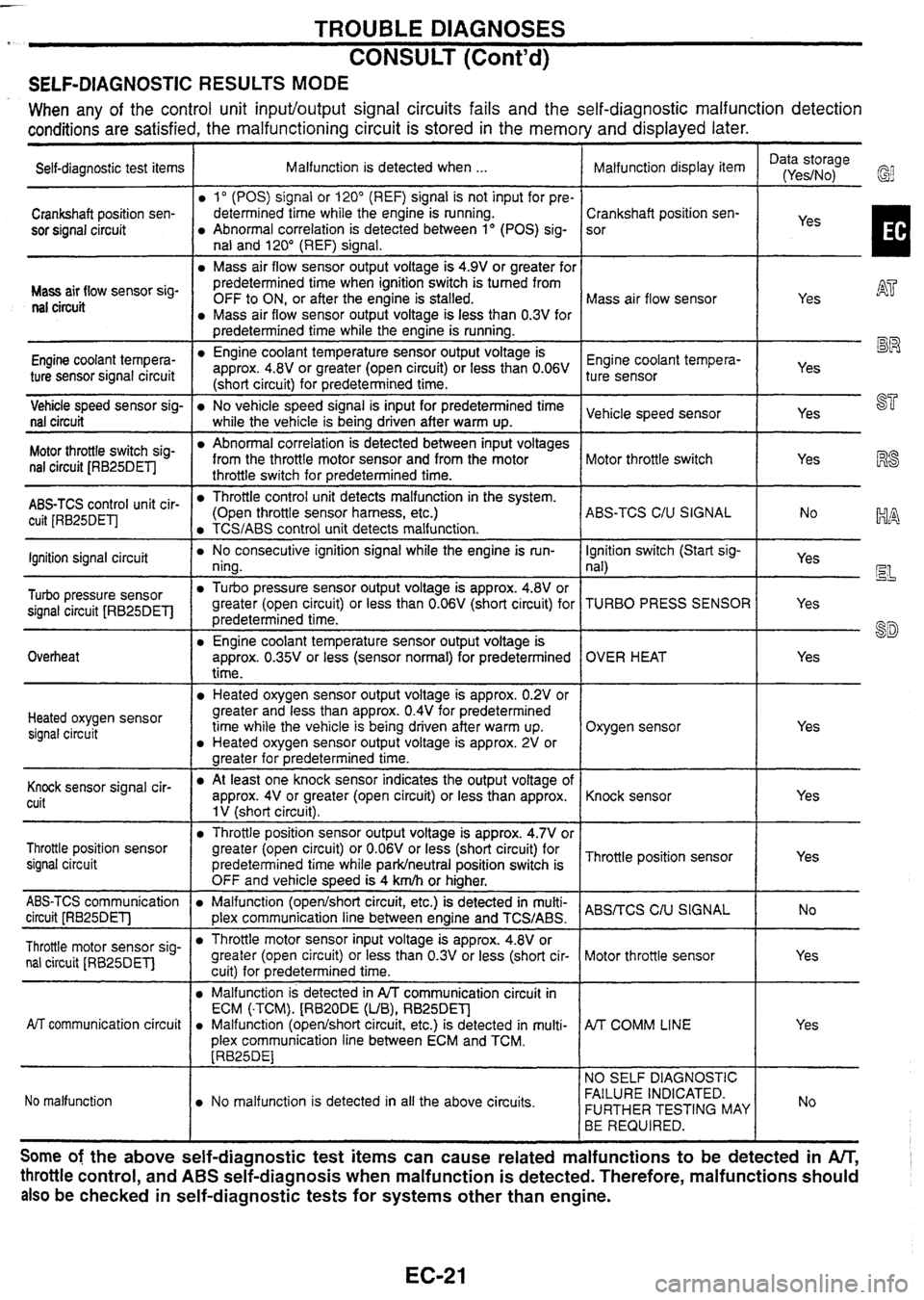
TROUBLE DIAGNOSES m
CONSULT (Cont'd)
SELF-DIAGNOSTIC RESULTS MODE
When any of the control unit input/output signal circuits fails and the self-diagnostic malfunction detection
conditions
are satisfied, the malfunctioning circuit is stored in the memory and displayed later.
Self-diagnostic test items I Malfunction is detected when ... Data storage
Malfunction display item I (Yes/No,
Crankshaft position sen-
sor signal circuit
I predetermined time while the engine is running. 1 1 mm
Mass air 'low sensor sig- nal circuit
1" (POS) signal or 120" (REF) signal is not input for pre-
determined time while the engine is running.
Abnormal correlation is detected between 1" (POS) sig-
nal and 120" (REF) signal.
Mass air flow sensor output voltage is 4.9V or greater for
Vehicle speed sensor sig-
No vehicle speed signal is input for predetermined time Vehicle speed sensor I I Yes ST nal
circuit I while the vehicle is beina driven after warm UD.
predetermined time when ignition switch is turned from
OFF to ON, or after the engine is stalled.
Mass air flow sensor output voltage is less than 0.3V for
Engine coolant tempera-
ture sensor signal circuit
Crankshaft position sen-
sor
Mass air flow sensor
AT
Yes RS
-.
yes I
Engine coolant temperature sensor output voltage is
approx. 4.8V or greater (open circuit) or less than 0.06V
(short circuit) for predetermined time.
switch sig- nal circuit JRB25DETI
Engine coolant tempera- ture sensor
Abnormal correlation is detected between input voltages
from the throttle motor sensor and from the motor
throttle switch for predetermined time.
ABS-TCS control unit cir- cuit [RB25DETJ
19 L~J
Yes
--
Motor throttle switch
lgnition signal circuit
Turbo pressure sensor
signal circuit [RB25DETl
Overheat
Yes
Throttle control unit detects malfunction in the system.
(Open throttle sensor harness, etc.)
TCS/ABS control unit detects malfunction.
Heated oxygen sensor signal circuit ABS-TCS
C/U SIGNAL
No consecutive ignition
signal while the engine is run-
ning.
Turbo pressure sensor output voltage is approx. 4.8V or
greater (open circuit) or less than
0.06V (short circuit) for
predetermined time.
Engine coolant temperature sensor output voltage is
approx.
0.35V or less (sensor normal) for predetermined
time.
Yes
Heated oxygen sensor output voltage is approx. 0.2V or
greater and less than approx.
0.4V for predetermined
time while the vehicle is being driven after warm up.
Heated oxygen sensor output voltage is approx. 2V or
greater for medetermined time.
Knock cuit lgnition
switch (Start sig-
nal)
TURBO PRESS SENSOR
OVER HEAT
Oxygen sensor
Yes Yes
EL
Yes
8D
Yes
At
least one knock sensor indicates the output voltage of
approx. 4V or greater (open circuit) or less than approx.
1 V (short circuit).
Throttle position sensor
signal circuit
ABS-TCS communication
Malfunction (openlshort circuit, etc.) is detected in multi- ABSrrCS C,u circuit [RB25DETl 1 plex communication line between enaine and TCS/ABS. I
Knock sensor
Throttle position sensor output voltage is approx. 4.7V or
greater (open circuit) or
0.06V or less (short circuit) for
predetermined time while
parkheutral position switch is
OFF and vehicle
s~eed is 4
km/h or hiaher. Thronle
position sensor
Throttle motor sensor sig- nal circuit
[RB25DET] Yes
AiT communication
circuit
Yes
Throttle motor sensor input voltage is approx. 4.8V or
greater (open circuit) or less than
0.3V or less (short cir-
cuitl for
redetermined time.
No malfunction Motor
throttle sensor
Malfunction is detected in A/T communication circuit in
ECM
(.TCM).
(RB2ODE
(UB), RB25DET]
a Malfunction (opedshort circuit, etc.) is detected in multi-
plex communication line between ECM and TCM.
[RB25DE1
No malfunction is detected in all the above circuits.
A/T COMM LINE
NO SELF DIAGNOSTIC
FAILURE INDICATED.
FURTHER TESTING MAY
BE REQUIRED.
Some of the above self-diagnostic test items can cause related malfunctions to be detected in An;
throttle control, and ABS self-diagnosis when malfunction is detected. Therefore, malfunctions should
also
be checked in self-diagnostic tests for systems other than engine.